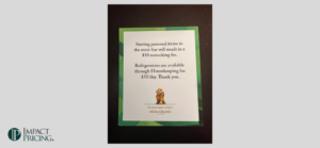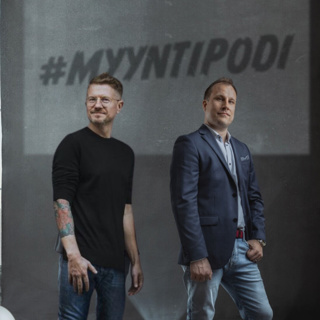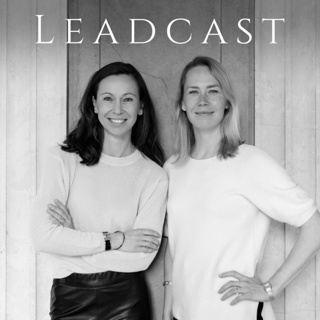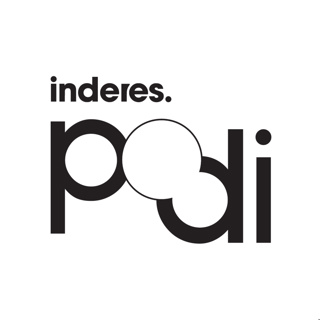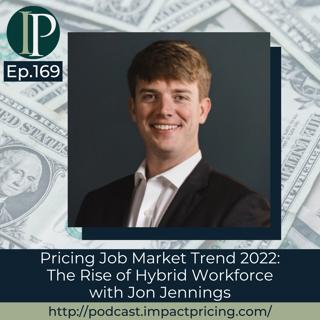
Pricing Job Market Trend 2022: The Rise of Hybrid Workforce with Jon Jennings
Jon Jennings is the Founder and Managing Partner of Jennings Executive Search, LLC. Jon is an official sponsor of this podcast. He began his career with a boutique recruiting firm, building relationships with C-Level accounting and finance professionals utilizing a research-based approach of study and analysis to best serve his clients. In 2012, Jon took this approach to a larger firm where he worked with several CFOs to build entire accounting and finance departments and gain a large firm perspective in how to build a successful practice. This experience led to the creation of Jennings Executive Search, LLC. In this episode, Jon discusses the current situation of the pricing market, specifically focusing on how things have developed since the pandemic began. Why you have to check out today’s podcast: Discover how the market has been like since the beginning of this pandemic; Learn about the difference of hybrid, in office, and at home settings, as well as how this difference influence today’s job search; and Find out why those people who are willing to learn the soft skills of pricing are the ones who are more likely to be promoted in a company “The people who get to move up are people who are adamant. They're persistent. They're not afraid to be uncomfortable in an uncomfortable conversation.” – Jon Jennings Topics Covered: 01:28 – The market’s situation since the pandemic began 04:17 – Talking about the expansion of pricing 06:01 – Everyone trying to figure out how to raise prices and putting hyper focus on it 08:49 – Are pricing people getting paid a lot more now than they were a year ago? 12:18 – Companies still not investing in pricing 14:48 – Are the requirements changing for pricing people? 18:35 – Those who are willing to learn make the biggest impact in a company 20:27 – How the difference between hybrid, in office, and at home settings influence today’s jobs 24:29 – Jon’s piece of pricing advice for today’s listeners Key Takeaways: “What's really happening in pricing has been happening for a long time, which is it's expanding; there's more jobs in pricing, and kind of separate to the current economic phenomena that we've seen over the last few years, it's been a space that's grown.” – Jon Jennings “There's a lot of openings in pricing and it's hard to find qualified people for them at the moment.” – Jon Jennings “I call it fittest athletes search. We just find the person that's most capable and learn the fastest and can just solve problems, solve business problems; they'd like to get in the business and figure things out and communicate cross functionally. Those are the traits I like to look for.” – Jon Jennings “The really good ones have a creative type of mind; not just they're good at analytics, but they have that creative side turned on and they can communicate very well. It's like yet to be everything at the same time. Those people are really impactful.” – Jon Jennings “You have to articulate the right way, that's digestible and understandable, and you got to win that meeting; and that's where you have to sell yourself, your abilities, all the time. That's really what makes you promotable.” – Jon Jennings “The way to have a big impact on your career is always selling. There's never a perfect solution; there's better and best. When you have something, be confident and don't back down. The squeaky wheel gets grease.” – Jon Jennings People / Resources Mentioned: McKinsey: https://www.mckinsey.com/ Bain: https://www.bain.com/ BCG: https://www.bcg.com/ KPMG: https://home.kpmg/ Simon Kucher: https://www.simon-kucher.com/ Connect with Jon Jennings: LinkedIn: https://www.linkedin.com/in/jonjennings/ Email: jon@jenningsexec.com Connect with Mark Stiving: LinkedIn: https://www.linkedin.com/in/stiving/ Email: mark@impactpricing.com
18 Huhti 202228min

Blogcast #50: The Value of Teachers vs. Athletes
This is an Impact Pricing Blog published on March 9, 2022, turned into an audio podcast so you can listen on the go. Read Full Article Here: https://impactpricing.com/blog/the-value-of-teachers-vs-athletes/ If you have any feedback, definitely send it. You can reach us at mark@impactpricing.com. Now, go make an impact. Connect with Mark Stiving: Email: mark@impactpricing.com LinkedIn: https://www.linkedin.com/in/stiving/
15 Huhti 20224min
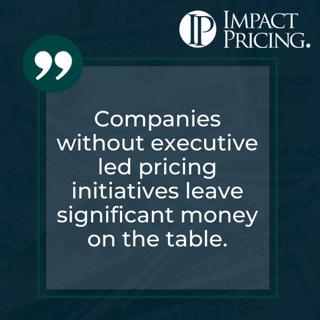
Memecast #53: Executive Led Initiatives
Let's face it, pricing people, we're typically smart. We have to interact and interface with lots and lots of different departments. But we rarely have the authority to make decisions that impact the entire company. These decisions could be changing pricing strategies, changing pricing metrics, focusing on market segments that we're going to go target. It could be getting product people to use value as they make decisions on which products to buy, or marketing people to document what value looks like as they're doing their marketing messages, teaching salespeople how to sell value. All of these are crucial when it comes to us helping the company win more deals at higher prices, but we don't have authority. What we do have is the knowledge typically to help these things happen. The only people in the company who have the authority to force these things through, to convince people who might be reluctant to say, "Yes, okay, let's go try it," are executives. If we don't have executives driving pricing initiatives, or even better yet, driving a culture of value. If our executives aren't doing this, we're leaving significant money on the table because there are lots of opportunities for us to go increase profit, we just don't have the authority. We hope you enjoyed this memecast. If you have any questions or feedback, please email me mark@impactpricing.com. Now, go make an impact. Connect with Mark Stiving: Email: mark@impactpricing.com LinkedIn: https://www.linkedin.com/in/stiving/
13 Huhti 20222min
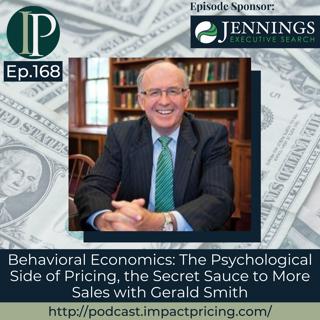
Behavioral Economics: The Psychological Side of Pricing, the Secret Sauce to More Sales with Gerald Smith
Gerald Smith is a Professor of Marketing at Boston College. He's been a Pricing Consultant with Strategic Pricing Group and Monitor Group since 1987. Gerald is the author of a relatively new book, “Getting Price Right: The Behavioral Economics of Profitable Pricing”. In this episode, Gerald discusses the power psychology holds in pricing in relation to behavioral economics as he talks about the soft side of pricing alongside the importance of framing. Why you have to check out today’s podcast: Find out what the hard side and soft side of pricing are all about, and why the behavioral side of pricing is more powerful than the logical side Understand why companies do framing, as well as why a frame of reference is important in pricing Discover why there’s power in psychology when talking about behavioral economics “Ask yourself and ask your pricing team, what do customers get and what do they pay for what they get? And say, is everybody in the industry doing it the same way?” – Gerald Smith Topics Covered: 01:39 – The start of Gerald’s pricing journey with Thomas Nagle and Reed Holden 03:08 – Gerald talks about his dissertation in relation to his new book, Getting Price Right 04:33 – The behavioral/soft side as potentially more powerful than the logical side 06:39 – The main point of Getting Price Right – the psychology of the sellers, the people that really set price 09:11 – Talking about the dominant pricing bias of salespeople giving discounts all the time 13:07 – Pricing strategy vs. pricing orientation 15:15 – Framing as one of the foundational theories of economics 18:09 – Discussion about Apple’s pricing slogan and the company having huge margins 22:45 – The power of behavioral economics – psychology; analysis vs. gut 24:12 – Talking about frame of references and setting price metrics 27:45 – Gerald’s piece of pricing advice for today’s listeners Key Takeaways: “We always think of pricing as a hard skill, as a quantitative skill. My students say to me, ‘Professor, tell me the formula for setting price.’ And I say, ‘No, no, no, folks.’ I mean, pricing is a soft skill that also brings in hard skills, for sure, so there are both skill sets.” – Gerald Smith “Sellers are also psychological and absolutely driven by psychology.” – Gerald Smith “One of the very dominant biases in pricing is that people have a tendency to discount price all the time. It's very irrational, and it, in fact, violates the principles of both psychology but especially economics, because economics says that people should rationally maximize the profits of the outcomes that are before them. And in the case of many people that apply this kind of discounting bias, they don't focus on the profits; they focus on the sales, and sales are not profits.” – Gerald Smith “Salespeople that work for somebody else are more likely to discount, but salespeople that do their own thing are less likely to discount. When they're selling their own place, they want to make sure that they maximize their profits if they can, but if they're selling for somebody else, they're happy to take that deal. That's because they get paid a commission on the deal. It is endemic to the world of pricing that people do this.” – Gerald Smith “Psychology is powerful. Analysis is terrific, but psychology is absolutely vital.” – Gerald Smith “Consumers or buyers give, but they also get. And so, if I can change what they get and what they give, then that can be very powerful.” – Gerald Smith People / Resources Mentioned: Getting Price Right: The Behavioral Economics of Profitable Pricing: https://www.amazon.com/Getting-Price-Right-Behavioral-Profitable/dp/0231190700 Freakonomics: A Rogue Economist Explores the Hidden Side of Everything: https://www.amazon.com/Freakonomics-Economist-Explores-Hidden-Everything/dp/0060731338 Connect with Gerald Smith: LinkedIn: https://www.linkedin.com/in/dr-gerald-smith-91b8383 Email: gerald.smith@bc.edu Connect with Mark Stiving: LinkedIn: https://www.linkedin.com/in/stiving/ Email: mark@impactpricing.com
11 Huhti 202230min

Blogcast #49: Indirect Customer Impact
This is an Impact Pricing Blog published on March 2, 2022, turned into an audio podcast so you can listen on the go. Read Full Article Here: https://impactpricing.com/blog/indirect-customer-impact/ If you have any feedback, definitely send it. You can reach us at mark@impactpricing.com. Now, go make an impact. Connect with Mark Stiving: Email: mark@impactpricing.com LinkedIn: https://www.linkedin.com/in/stiving/
8 Huhti 20223min
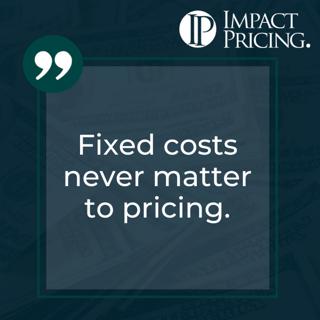
Memecast #52: Fixed Costs
This one may be intuitive, may not be intuitive, but it turns out that if your fixed costs change, for whatever reason, if they go up, if they go down, it really should have no impact whatsoever on your pricing. For example, let's say you need to buy a new piece of factory equipment, and it's really expensive, and it makes your fixed cost go way up. Did buying that new piece of factory equipment for you change your customer's willingness to pay? No, it didn't. Customers are still willing to pay the same amount. They still can choose between you and a competitor. Well, did you changing your fixed costs changed the way your competitor prices for whatever reason? No, it doesn't. The only thing that matters to us when we're doing pricing is thinking about how our customers are making decisions and how we can make optimal decisions based on that. And I can assure you that your fixed costs have absolutely nothing to do with how much your customers are willing to pay. For that reason, your fixed costs never matter to pricing. We hope you enjoyed this memecast. If you have any questions or feedback, please email me mark@impactpricing.com. Now, go make an impact. Connect with Mark Stiving: Email: mark@impactpricing.com LinkedIn: https://www.linkedin.com/in/stiving/
6 Huhti 20221min
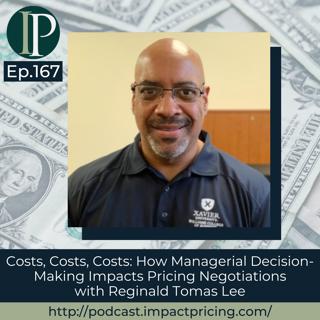
Costs, Costs, Costs: How Managerial Decision-Making Impacts Pricing Negotiations with Reginald Tomas Lee
Reginald Tomas Lee is a Professor of Business Analytics at Xavier University in Cincinnati, Ohio. He has a PhD in Mechanical Engineering, and he's been involved in supply chain since ’96. Reginald’s most recent book is called Project Profitability. And one fun thing, he can't go on vacation, because he has two killer dogs. In this episode, Reginald shares wisdom with regards to the modeling he’s been making as he talks about the power of helping people understand more clearly how what it is that they do impacts cash. Why you have to check out today’s podcast: Understand why you should start seeing things from a cash perspective in relation to knowing what it is that it enables you to save Learn about the difference of cash cost and non-cash cost through situational examples from real life experiences Find out how your actions and decisions impact how you generate cash in a business “Don’t focus on accounting margins.” – Reginald Tomas Lee Topics Covered: 01:17 – How Reginald shifted from being a mechanical engineer to thinking about supply chains and costing 03:44 – What Reginald does: Helping people understand how their decisions impact cash 07:18 – Talking about contribution margins: Accounting for things from a cash perspective 11:09 – How to figure out the optimal price without using some measure of contribution margin 14:34 – Hope as a strategy: Mark’s opportunity cost vs. Reginald’s opportunity revenue 17:15 – Two types of costs: The cash cost and the non-cash cost 21:41 – Reginald’s sales pitch: Very specifically identifying what the savings are 24:02 – Discussion about Mark’s value table and Reginald’s improvement projects 27:59 – Projecting revenue and the uncertainty that comes with it 30:24 – Reginald’s piece of pricing advice for today’s listeners Key Takeaways: “We should shift away from looking at accounting data and look specifically at operations and cash.” – Reginald Tomas Lee “From a cash perspective, materials and labor don't vary. When we look at contribution margins for products that we make, and we assume that those costs vary and they affect the contribution margin, my argument is they don't vary. And so therefore, it's not a reflection of cash.” – Reginald Tomas Lee “As we know, hope’s not a strategy. We’re hoping that the demand would be there, but I've seen situations, actually, where people have bought more just to get a lower price so that they can report a higher gross margin. It's not a good business decision at all. And that's why I shift over to cash, because cash will tell you don't do that, but accounting may, because I can put it in inventory.” – Reginald Tomas Lee “If you want to save money, what you have to do is basically buy fewer people. Buy four people instead of buying 10 people. Buy less capacity, then I'm spending less money.” – Reginald Tomas Lee “I focus specifically on what changes the software will enable, and then point out that if you want the cash savings, you need to make managerial decisions. You have to make a decision to get rid of the four people because the software is not going to fire them. That's what you have to do. The software is not making the cost savings happen. It's my management decision and action that was at that.” – Reginald Tomas Lee “I define efficiency as engineers do – output over input. So, if my input is my organization, what I'm spending on the organization, and the output is what it is that they can do, then what this will do is that we’ll generally allow them to either create more output with the same group, or consume less of that group to create the existing amount of output. But the size of the organization itself doesn't change until I, as a manager, change it.” – Reginald Tomas Lee “Based on how we choose to calculate this cost, that may have an impact on whether we take the business or not. So instead of focusing on accounting margins, if you can take a look at the cash impact of the decision that you make, then I think you'll be in a much better position to be able to negotiate price and feel good about taking prices that in some cases you may not have taken just because someone calculated a number that happen to be lower than someone else's calculation.” – Reginald Tomas Lee People / Resources Mentioned: Project Profitability: https://www.amazon.com/Project-Profitability-Ensuring-Improvement-Projects/dp/1637421699 The Goal: https://www.amazon.com/Goal-Process-Ongoing-Improvement/dp/0884271951 Connect with Reginald Tomas Lee: Email: reginald.lee@bdrco.org LinkedIn: https://www.linkedin.com/in/reginaldtomas/ Connect with Mark Stiving: LinkedIn: https://www.linkedin.com/in/stiving/ Email: mark@impactpricing.com
4 Huhti 202232min

Blogcast #48: Direct Customer Impact
This is an Impact Pricing Blog published on February 23, 2022, turned into an audio podcast so you can listen on the go. Read Full Article Here: https://impactpricing.com/blog/direct-customer-impact/ If you have any feedback, definitely send it. You can reach us at mark@impactpricing.com. Now, go make an impact. Connect with Mark Stiving: Email: mark@impactpricing.com LinkedIn: https://www.linkedin.com/in/stiving/
1 Huhti 20223min
